Crew 281 GreenHab Report 23 May 2023
GreenHab Officer: Megan Kane
Environmental control: mixed door open/ door open with fan
Average temperatures: 91.38 °F
Hours of supplemental light: None
Daily water usage for crops 1.19 gallons
Daily water usage for research and/or other purposes: 0.4 gallons
Water in Blue Tank 159.53 gallons
Time(s) of watering for crops:
0945: refilled 4 water bottle (2 L) watered other plants as needed 2.5 L
Changes to crops:
None
Narrative:
In the morning the GreenHab was checked and watered. The cooling cloth’s reservoir was also refilled. The temperature was checked several times. The highest recorded temperature today was 110.5.
Harvest: (include which crop and mass in grams): None
Support/supplies needed: None
EVA Report – May 23rd
Crew 281 EVA Report 23-05-2023
EVA # 10
Authors: Ritupriya Patil (Executive Officer), Ana Pires (Crew Scientist)
Purpose of EVA:
Drone flight to record and do aerial imagery for new exploration areas
Acquire vertical images and videos for previously done geotechnical survey of Pooh’s Corner
Start time: 0750 hrs
End time: 1038 hrs
Narrative:
This was first long EVA with a crew of two. At 0745 hrs the crew entered the airlock exiting at 0750 hrs. They first checked all the rovers and collected the hours and SoC information, and it was verified that all were securely plugged in. They then unplugged Opportunity and headed out for the first destination at 0758 for the intersection of Cow Dung and Hwy 1572. The area was interesting due to the geological features that made a unique mix as if they were partly from moon and mars. The crew witnessed shades and combinations of red and white at various locations around. On arrival to the site, Ana (Crew Scientist) collected 9 rocks (270 g) and soil (55 g). It was drizzling initially but the clouds dispersed by the time the crew arrived and Ritu (XO, EVA Lead) was able to deploy the drone at 0845, capture aerial imagery and videos, and land at 0855 with a 58% battery.
For the next stop, the crew wrapped up and drove on Hwy 1572 until they arrived at the ‘Y’ fork at the Overlook region. Weather was perfect, bright and sunny. Ritu was able to record good footage of the site, with the drone deployed at 0912 and landed at 0924 with 15% battery remaining. Meanwhile, Ana collected 9 rock samples for total of 206 g.
The crew then left for Pooh’s Corner on their way back and acquired vertical and oblique drone images and videos for previously done geotechnical survey for control point 2. This will aid to georeferencing the region under study. The drone batteries were swapped, drone was deployed at 1016 (at 97% battery), the winds had picked up by this time , but the drone was successfully landed at 1025 with 57% battery. The crew left for MDRS right after and arrived at 1037.
During the EVA, the crew observed that Opportunity rover experienced faster drop in the initial 15-20% of battery SoC. By the time they got to the Overlook (almost 7 Km), the charge had dropped to 67%. However, after that the rover’s performance was good and, on the journey back, the SoC was 57%.
Water checks were done approximately every half an hour.
Overview of EVA
Drove to the intersection of Cow Dung and Hwy 1572 and then walk no more than a radius of 100m to explore the area
Drove further on Hwy 1572 to explore the Overlook region, while walking no more than a radius of 500m
On the way back stopped at Pooh’s Corner, walking no more than a radius of 500m;
Issues Experienced During EVA
Comms issues throughout. This was expected per Mission Support’s advice.
Weather was initially an issue with drizzle and winds
XO, suite buckle came undone a couple of times while retrieving the drone from travel packaging. It could have been due to inadvertent pressure on the belt buckle and it popped open.
Outcomes
Crew completed Rover checks
Explored intersection of Cow Dung and Hwy 1572 area, collected soil and rock samples, and drone footage
Explored the Overlook region9 rock samples for total of 206 g and drone footage
Collected drone footage of survey area at Pooh’s Corner collected
Collected 18 rocks, 479 g; 1 tube of soil, 55 g
Destination: MDRS Hab and surrounding 500 m radius
Coordinates :
(use UTM WSG 84): 517533E, 4254823N
(use UTM WSG 84): 516055E, 4254568N
(use UTM WSG 84): 519025 E, 4251183 N
EVA Participants 2: Ritupriya Patil (XO, EVA Lead), Ana Pires (Crew Scientist)
Road(s) and routes per MDRS Map:
Drive on Cow Dung Road take left on Hwy 1572, park on the side of intersection
Drive on Hwy 1572 until the ‘Y’ fork at the Overlook region
Drive on Cow Dung Road and walk left hand side to Pooh’s Corner, scanline boulders
Mode of travel: Rover
Crew Photos – May 22nd
Sol Summary – May 22nd
Crew 281 Sol Summary Report 22 May 2023
Sol: 8
Summary Title: Hair wash day
Author’s name: Ritupriya Patil (XO) and Megan Kane (Commander)
Mission Status: Nominal
Sol Activity Summary:
EVA:
Today’s EVA was at Pooh’s corner. The crew of 3 drove Spirit and Perseverance rovers and reached the site at 0823 hrs. They captured scanline measurements for the boulders Ana Pires (Crew Scientist) approved at Pooh’s Corner. KC Shasteen helped with the Equotip measurements while Ana gathered the Schmidt hammer data. The crew finished a 5 station long scanline and during their measurements Ritupriya Patil (XO, EVA Lead) deployed the drone for aerial imagery. Detailed vertical images and videos of the scanline were captured to help confirm the weathering grade, discontinuities of the rocks. These images and videos will be used for georeferencing the area around the scanline and for further assessment of the geological region. The objective was achieved right before winds gusted to 27 kmph and the drone was secured.
For lunch Ritu (XO) made tofu Thai curry with white rice. Post lunchtime Ritu and Ana worked on tomorrow’s EVA planning, looking at maps, distance and noting time for each stop over during the 2 person EVA. Then Ritu and KC worked in the RAM to build a drone packaging so it can be securely stored during the travel time in a ready to be deployed configuration. This makes the drone launch much faster and efficient.
Rachel (HSO) checked into OMISS Old Man International Side band Society through the ham radio setup. She is working through troubleshooting the power reception she is having. While Ana worked on closing the set of scanlines and working further on research and synergies with Ritu. KC and Rachel had a hair wash day to clear their heads (get that?!).
In the green hab, Megan (Commander) watered and checked on the plants. KC (Crew Engineer) did routine checks on hab operations – batteries, tunnels, flushed toilet and water levels. Ana cleaned up her robotic scoop in the RAM after a successful mission today.
In the science dome Megan checked on the cacao seeds and made a video recording the changes to the seeds.
For dinner Rachel made stamppotten a mashed potato dish from the Netherland. It rained in the late afternoon and there were storms, but the antenna stayed upright.
Look Ahead Plan: Tomorrow we will do a 2-person, long range EVA to the Overlook region. It will be an all-female crew exploring the Martian surface and capturing aerial footage. On our way back we will stop at Pooh’s Corner for images of scanlines that were measured on earlier EVAs.
Anomalies in work: None
Weather: Windy
Crew Physical Status: Nominal
EVA: Completed 1 today
Reports to be filed:
Greenhab Report
EVA Report
EVA Request
Ops Report
Journalist Report
PHOTOS!
Photo of the Day
Support Requested:
Mission support is requested in case of storms if the antenna needs to come down or be retrieved.
Operations Report – May 22nd
Crew 281 Operations Report 22 May 2023
SOL: 8
Name of person filing report: Megan Kane (Commander), Ritupriya Patil (Executive Officer) and KC Shasteen (Crew Engineer)
Non-nominal systems:
Electrical outlets in kitchen
Remote observatory
EVA Helmet
Notes on non-nominal systems: None
ROVERS
Spirit rover used: Yes
Hours: (before EVA): 222.2
Hours: (after EVA): 222.5
Beginning charge: (Before EVA): 100%
Ending charge: (On return from EVA, before recharging): 78
Currently charging: Yes
Opportunity rover used: No
Hours: (before EVA): 130.0
Hours: (after EVA): NA
Beginning charge: (Before EVA): 100%
Ending charge: (On return from EVA, before recharging): NA
Currently charging: Yes
Curiosity rover used: No
Hours: (before EVA): 240.2
Hours: (after EVA): NA
Beginning charge: (Before EVA): 100%
Ending charge: (On return from EVA, before recharging): NA
Currently charging: Yes
Perseverance rover used: Yes
Hours: (before EVA): 264.3
Hours: (after EVA): 264.6
Beginning charge: (Before EVA): 100%
Ending charge: (On return from EVA, before recharging): 66%
Currently charging: Yes
General notes on rovers: None
Summary of Hab operations:
WATER USE: 39.9 gallons
Water (static tank): 281.9 gallons
Static tank pipe heater (on or off): off
Static tank heater (On or off): off
Toilet tank emptied: yes
Summary of internet:
nominal
Summary of suits and radios: All suits and radios are fully recharged.
Summary of GreenHab operations:
WATER USE: 2.64 gallons
Heater: Off
Supplemental light: Off
Harvest: in grams : 0
Summary of Science Dome operations:
Dual split: Heat and AC, Off
EVA & Research Planning
Cacao Experiment:
Watered cacao seedlings
Summary of RAM operations: (Tools used, work done)
Fixed Patches for Ana and KC
Fabricated restraint for carrying drone on EVA
Summary of any observatory issues: NA
Summary of health and safety issues:
No new issues to report.
Questions, concerns and requests to Mission Support:
Request Mission Support assistance to take down or retrieve the ham radio antenna in case of emergency or high winds.
Journalist Report – May 22nd
Crew 281 Journalist Report 22 May 2023
Journalist Report
By: Rachel Jones
Sol 8, Getting Our Procedures Straight.
It’s Sol 8, and things are starting to feel like clockwork. Everyone knows I’ll ask them if they have water, if they’ve been drinking water, if they brought extra water, etc. etc. etc. Our EVA of Ana, Ritu, and KC went to Pooh’s Corner test to perform the last scan line and take aerial footage. Our Crew has taken over 950 measurements of rock hardness with the Equotip and Schmidt Hammer. The crew has the system down to a point where neither the slightly damp ground nor the poor band signal interfered with the mission.
Lunch today, prepared by Ritu, was Tofu Thai Curry and white rice. I spent my lunchtime hour trying to check into the Old Man International Sideband Society’s (OMISS) daily net. For those not into amateur radio, a “net” is traditionally an on-the-air gathering. I was on 20 meters and could barely be heard. I plan to try again tomorrow and see if I can get through. You can check them out on www.omiss.net.
After lunch, the great hair-washing experiment commenced. Our goal was to use as little water as possible. We averaged about 3/4s of a gallon per person. We then reused the hair-washing water to top off and flush the toilet system. From cooking to basic chores, we like to make every drop count. After my hair was washed, Megan our impromptu stylist, put it up in a French braid.
The afternoon sent everyone off to their various tasks. I collaborated with various radio operators to try and diagnose my radio set up to be clearer. KC and Ritu constructed a new on-EVA drone transportation system so that the drone could be carried in a ready-to-be-deployed configuration (gloves make it hard to do in the field). Ana and Ritu then planned out tomorrow’s EVA. Megan took care of the GreenHab and her chocolate plants. The chocolate plants are starting to sprout now.
Dinner tonight was up to me. For all those of you that have waited with bated breath to learn what-all is involved in cooking at MDRS, wait no longer. Given the variety of options we had, I chose to make a MDRS version of stamppotten, a potato and vegetable dish. First, I gathered the various vegetables I wanted to include. Each ingredient had a different amount of time it needed to rehydrate. I put about two tablespoons of the first two ingredients (carrot flakes and cheese gratings) in a large bowl and added warm water. They needed 15 mins to rehydrate. Five minutes later, I added the next two veggies (onion flakes and peppers bits). Then 5 minutes later I added the last two ingredients (spinach flakes and butter powder). On the stove, I put in
2 cups of the instant mashed potatoes mix, salt, garlic, and some of the rehydrated milk mix. Then I added the hydrated vegetables (along with the excess water) into the potatoes and brought it to a quick boil. I think it turned out fantastic.
Feeling full and happy, I bid you all ado for tonight.
GreenHab Report – May 22nd
Crew 281 GreenHab Report 22 May 2023
GreenHab Officer: Megan Kane
Environmental control: mixed door open/ door open with fan
Average temperatures: 87.78 °F
Hours of supplemental light: None
Daily water usage for crops 2.25 gallons
Daily water usage for research and/or other purposes: 0.4 gallons
Water in Blue Tank 161.12 gallons
Time(s) of watering for crops:
0720: refilled 5 water bottle (2.5 L) watered other plants as needed 3.0 L
1813: refill 3 water bottles (1.5L) and watered other plants as needed 1.5L
Changes to crops:
Tomatoes and cucumbers almost ready to harvest.
Narrative:
In the morning the GreenHab was checked and watered. The cooling cloth’s reservoir was also refilled. The temperature was checked several times. The highest recorded temperature today was 102.7.
Harvest: (include which crop and mass in grams): None
Support/supplies needed: None
EVA Report – May 22nd
Crew 281 EVA Report 22-05-2023
EVA # 9
Authors: Megan Kane (Commander), Ritupriya Patil (Executive Officer), Ana Pires (Crew Scientist)
Purpose of EVA:
Conduct Geotechnical Survey of the area and geomechanical assessment
Schmidt Hammer and Equotip measurements along scanlines
Geological and geotechnical assessment of the scanline using the created datasheet by the Crew Scientist
Acquire images and collect loose rock/soil samples
Drone flight to record all of the above operations and do aerial imagery
Start time: 0834 hrs
End time: 0939 hrs
Narrative:
At 0801 the three members of the EVA entered the airlock exiting at 0807. They first checked all the rovers and collected their information. Hours and State of Charge were recorded for each vehicle and it was verified that all were securely plugged in. They then unplugged Spirit and Perseverance in preparation for heading out to Pooh’s Corner (Site). They left at 0814.
EVA Crew arrived at Site 0823. After parking the rovers the crew did a visual survey of the area to locate a good location for the scanline. At 0806 the crew conducted a water break. They chose the location and laid the scanline. Measurements commenced at approximately 0834. There were 5 stations total. See the completion times below:
Station 1 complete at 0838.
Station 2 complete at 0851
Station 3 complete at 0858
Station 4 complete at 0906
Station 5 complete at 0910
Water checks were taken approximately every half an hour. Samples were collected near the scanline after station 5 was complete. When station 3 began at 0840 drone setup was started. Drone was launched at 0840. The wind was very high and the drone was unable to complete the planned shots. The drone landed at 0900.
At 0919 the crew headed back to the rovers. At 0922 they started back to MDRS in rovers arriving at 0930. The crew re-entered the airlock at 0934 and the hab at 0939.
The crew did not stop over at Marble Ritual for drone footage due to high winds.
Overview of EVA
Drove to Pooh’s Corner
Completed a scanline
Took drone footage for georeferencing
Issues Experienced During EVA
Comms issues throughout. We expect this is due to the high inference on the bands from the current space weather.
Winds too high to get all desired imagery.
Outcomes
Crew completed Rover checks
Crew drove to Pooh’s Corner Ridge
Crew Completed Geological survey
Drone footage of survey area at Pooh’s Corner collected
Collected 6 rocks, 936 g; 1 tube of soil, 49 g
Coordinates (use UTM WSG 84): 519025 E, 4251183 N
EVA Participants 3: Ritupriya Patil (XO, EVA Lead, KC Shasteen (Crew Engineer), Ana Pires (Crew Scientist)
Road(s) and routes per MDRS Map: Drive on Cow Dung Road and walk east until Pooh’s Corner.
Mode of travel: Rover
Crew Photos – May 21st
Research Report – May 21st
[category science-report]
Crew 281 Mid-Mission Research Report
Date: 05/21/2023
Introduction
The team is halfway through the 14 day mission. No plan survives contact with reality; however, the Pegasus Crew has made steady progress on all of their research goals. Each crew member has provided an update on their research and activities in their own words.
-
Megan Kane: Commander and GreenHab Officer
-
Ritupriya Patil: Executive Officer and Crew Scientist
-
Rachel Jones: Health Safety Officer and Journalist
-
Ana Pires: Crew Scientist
-
KC Shasteen: Crew Engineer (editor)
Each day has been an adventure with new learning experiences and activities. Most days there has been 1 or 2 Extra-Vehicular Activities (EVAs).
Research and Activities Updates
Megan Kane – Commander and GreenHab Officer
Three main projects have been worked on outside of the daily activities of keeping the crew and mission running.
Cacao (Chocolate) Seed Propagation.
The science dome has a grow tent that is being used for the cacao seed propagation. So far, the following steps have been completed:
-
Seed pods opened and seeds removed
-
Seeds cleaned
-
Seeds laid out for germination on trays with moist paper towels
-
Clean seeds a second time and replace paper towels
-
Transplant all seeds that have sprouted roots into pots
It is anticipated that in the next few days the first 2 leaves (cotyledons) will be visible. The temperature and humidity of the grow tent is being recorded.
GreenHab Usability Extension
The GreenHab does not usually run this late in the season. With the assistance of the Crew Engineer, KC Shasteen, several simple changes are being tested to extend the usability of the GreenHab. These include:
-
adding an airflow diverter to keep the fan from blowing directly on the plants. Doing so causes excessive drying of the plants if the airflow is too strong
-
testing low tech methods to improve airflow and humidity
The airflow diverter designed and fabricated by KC has 45 degree slats which push the air from the fan up and over the plants. It greatly increases the airflow throughout the GreenHab by creating a circulation air from the fan across the ceiling and down the rear wall. Added to this is a spacer that holds open the louvers on the airflow exit vent, which allows a chimney effect to draw additional air across the GreenHab from the door to the vent. This spring-loaded vent would normally open from over-pressure when the fan is on and the door is closed. However, based on the recommendation of MRDS Mission Support the door was left open for airflow and cooling. Combining the open door with the open louvers creates a cross breeze inside of the GreenHab which decreases the temperature and relieves heat stress on the plants.
Passive Irrigation System
The passively pumped irrigation system was installed on Sol 1 in the GreenHab. There are 10 planters which now receive their water using terracotta watering spikes. The consumption of water is being tracked for the control planters (water by manual pouring) and the test planters (water using the terracotta spikes). After the mission the watering data will be analyzed to see if there were any statistical differences.
Ritupriya Patil: Executive Officer and Crew Scientist
Behavioral Studies Research:
The 7 Sols spent on the red planet have been an exhilarating experience. A strong sense of camaraderie and teamwork permeates the crew, as they assist one another in accomplishing research objectives and maximizing the mission’s potential. The MDRS mission for crew 281 has provided us with a fresh perspective in preparation for future Mars expeditions. From adhering to morning rituals and preparing meals using freeze-dried food to practicing water conservation and prioritizing each other’s safety, the crew has demonstrated our dedication. We have also actively engaged in engineering solutions and research endeavors to optimize their time at the MDRS. Additionally, I have participated in the MDRS Behavioral Study program, collaborating with the University of Central Florida. This opportunity has granted valuable insights into the role of emotions within Isolated, Confined, and Extreme (ICE) environments. During the stay at the MDRS, contributions are being made to the behavioral studies research by providing daily logs and surveys, thereby assisting in the accumulation of data.
Crew Scientist Research – Investigation of Drone Technology for Georeferencing and Emergency Assistance
The focus of this research is to examine the potential applications of drone technology in supporting astronauts during Mars surface exploration while emphasizing the importance of astronaut safety during extravehicular activity (EVA). The objectives include georeferencing, route planning, emergency medical assistance, and documentation of EVA activities.
To achieve the first goal, research work was done in collaboration with Ana Pires (Crew Scientist) and KC Shasteen (Crew Engineer). To aid Ana Pries’ rock hardness testing and scanline measurements for the chosen boulders under study, detailed vertical and diagonal drone footage was captured for each scanline. These images and videos will help confirm the weathering grade and discontinuities of the rocks. Various drone flying techniques were explored and successfully recorded the scanline footage. High altitude (below 120 m) imagery was captured to georeference the MDRS and surrounding region.
The second objective was achieved by performing a drill EVA mission around the Hab with an emergency scenario simulating an injured astronaut being delivered a lightweight emergency kit. The first proof of concept experiment established a baseline, more work will be done over rest of the mission to deliver at longer ranges and using more efficient routes.
For the final objective, drone footage documentation has been contributed to 4 of the 8 EVAs so far. The plan is to continue collecting videos and images for crew research and outside Hab activities, as needed, for the remaining EVAs. The total drone flight time so far is recorded to be 1 hour and 45 minutes.
The acquired data and insights have the potential to significantly contribute to the advancement of knowledge and understanding in the field, ultimately facilitating safer and more effective exploration of the Martian landscape.
Pictures above starting clockwise from top left
-
Aerial shot of the MDRS campus captured via drone
-
Deploying the drone for first time on MDRS campus to get georeferencing footage.
-
Working on the payload harness for drone to deliver during the drill
-
Kissing Camel Ridge captured on drone during our 6th EVA
-
Drone returning after dropping the payload to simulate emergency medical assistance.
Rachel Jones: Health Safety Officer and Journalist
Re-Establishing Amateur Radio Communications
In October 2022, before the start of the 2022-2023 MDRS season, an amateur radio station was established at MDRS. The station was designed by 16-year-old Hope Lea (ND2L). She set up the station as part of NASA sponsored Spaceward Bound Utah, which featured the first all high school crew at MDRS.
The station comprised of a Shack-in-the-Box set up containing an I-Com 7300 radio, LDG Tuner, and an external speaker. The Shack-in-the-Box, which is a name brand many amateurs might call a go-box, is then either connected to the wall outlet or a battery for power. The battery configuration allows a station to be ran both on-the-grid or off-the-grid as a possible POTA (Parks-on-the-Air) station. The kit holds two coax cables, likely for redundancy, as only one is needed to connect the go-box to the antenna. The station uses a versatile Chameleon High Frequency (HF) Modular Portable Antenna System 2.0 which has nine different configuration possibilities.
After an inventory of the station (Sol 4), practice configuration, and team deployment training (Sol 5), the station was finally set up on Sol 6.
Rachel deploys and operates the MDRS amateur radio station.
Ana Pires: Crew Scientist
Narrative:
One week ago, Ana had the opportunity to see the Mars Desert Research Station for the first time and to “breathe” on Mars! She woke up early every day to watch the sun starting to shine in this wonderful and unique geological setting. As a researcher and a geoscientist, she will carry all these colors in her memory for all her life! However, she is on Mars, so everything must be planned with the Commander, the team, and the mission support.
Geosciences, geotechnics, and technology on Mars is hard. Ana’s research includes a geological-geotechnical assessment of the area (using scanline surveys adapted from ISRM, 1981), as well as a geomechanical characterization of the rock hardness using Equotip and Schmidt hammer (non-destructive testing equipment). The research also includes the testing of a rock sampling device (scoop prototype) in a real environment and the registration of possible future adjustments.
The Crew Scientist is collaborating with Portuguese researchers involved in the field of engineering materials, so the Crew was able to wear T-shirts and boxers (Smart Textiles) designed for extreme environments, during their EVAs. The feedback is positive, and the team has already provided a lot of suggestions and recommendations to improve the design.
The Crew Scientist has been producing a series of educational & outreach videos about her time spent on our Utah campus for students in Portugal, under the scope of “Space For All Nations Initiative” (run by International Institute for Astronautical Sciences) and also for her project “Portuguese GeoTech-Vision for STEAM Outreach and Education”.
Human relationships are an important part of this mission and were also part of her personal learning at the MDRS. Listening to the Commander, Megan Kane, talk about her stories in Africa, or speaking Chichewa language, her dogs, her passions… Ritupriya Patil (Executive Officer) the serenity that we need during these days on Mars, Rachel Jones (Crew Journalist and HSO) a force of Nature offering us the boost that we need to “survive”, and finally KC Shasteen (Crew Engineer), which offers us generosity and intelligence.
Ana is eager to know more about this awesome Team. The mission is still ongoing… The Crew Scientist will continue listening to the sounds of Mars, breathe Science and Technology, knowing that the MDRS will be forever in her heart.
Crew 281 activities
The week included several EVAs with the Crew Engineer and XO, where it was possible to adapt for the first time to wearing the spacesuits, handling items with gloves, driving the rovers, performing all the proposed tasks with a mind for safety, and readjusting the methodology used during the geotechnical assessment. Mars is testing the Team Pegasus every day and pushing it to the limit. The passion for Science and Technology really overcomes all the challenges that the Crew faced this first week.
MDRS Analog Mission in 2 words: adaptation and “saudade” (Portuguese word)
The research in numbers: Three scanlines; total length of scanline 65 m; 14 stations; 2 types of equipment for rock hardness; 2 humans; 700 measurements; > 5kg rock samples; > 200g of soil samples; 1 test with the rock sampling device (named “Pegasus” scoop); > 1500 images and videos acquired.
Next steps: The final week will be dedicated to carry out the last scanline in Pooh’s Corner and more EVAs in other locations for rock/soil sampling and visual observation of the geoforms and geology. A second test will be conducted with “Pegasus” scoop.
Clockwise from left: Ana using Schmidt Hammer, KC using Equotip, Ana holding Portuguese Flag, KC-Ana-Ritu (let to right), Ana installing scoop in dirt.
Looking Forward
Now that the team has passed the halfway point of the mission the focus will be on finalizing data collection and wrapping up experiments.


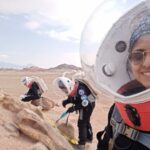
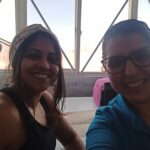
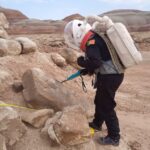
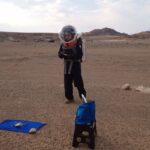



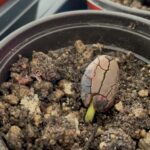
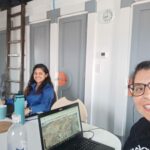
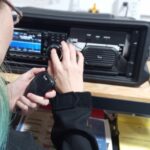
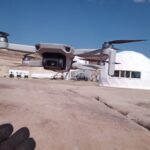
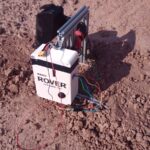
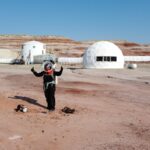
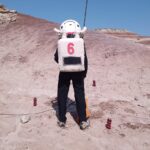
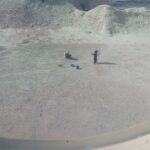





You must be logged in to post a comment.